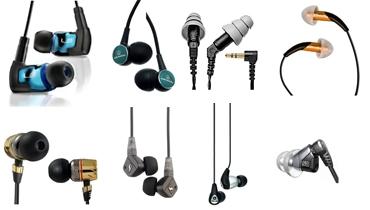In-Ear Headphones Face Off

Back in the early days of portable music players and digital downloads, your average audiophile could legitimately look down his (or her) nose at the whole notion and say, "Feh!" Boy, have times ever changed. Thin-sounding low-resolution MP3 files have given way to high-rez downloads and lossless rips, while computer sound cards and Apple's ubiquitous portables (which more or less own the market now) have noticeably upped the quality of their digital-to-analog processing and amplifier circuitry. And the high-end headphone options for portables have really flourished. Yes, Apple still ships the iPod with throwaway earbuds that no mortal should be forced to listen with. But where serious audiophiles were once forced to carry around giant 1970s-style ear cans as their replacement, today we've got a whole slew of compact, high-performance in-ear monitors that will simply astound you with their miniscule form factor and sound quality. I should know - I just listened to a good number of them side by side.
The eight earphones that faced off in this survey carry list prices ranging from $250 to $450, with six falling in the heavily represented $300-to-$400 range. Some are considered classics, such as the entry from Etymotic Research, a firm that, along with Shure, can fairly be said to have created the category. Other companies, including Ultimate Ears, Sleek Audio, and Monster, are either comparative newcomers or relative unknowns in this field. And the rest - Shure, Klipsch, Sennheiser, and Audio-Technica - are old audiophile brands that have proven themselves in loudspeakers, microphones, or other segments of the earphone category before turning out a highperformance in-ear model. Putting together a test procedure that allowed me to hear real differences among these 'phones under the same conditions required some thought - and also some choice test tracks. Save for one model that was considerably worse than the others in delivering low-end bass - which is really what you pay for at this price level - all the 'phones delivered pretty impressive sonics. But in the end, the cream definitely rose, and some winners emerged.
MINI MAGIC
Before getting on with the individual reviews, it's worth explaining what's in these tiny little earphones and how they pull off the trick of delivering fullrange sound without a 15-inch woofer and a giant cabinet. Bottom line: If you don't have a rack full of gear and big speakers to excite the air in the room, the next best thing is to get the transducer as close as possible to the eardrum. That's why in-ear phones are the best option for audiophiles; by more or less sealing the transducer to the ear canal, engineers can create pressure that's otherwise lost with other 'phone-types.
Consequently, getting the right fit is extremely important if you expect in-ear headphones to perform as advertised. The very best in-ear monitors, including the Ultimate Ears model UE11 Pro that I own personally and used as a reference for this test, are custom-created to fit your ear from a mold made by an audiologist. There are trade-offs with this approach versus traditional rubber or foam ear tips in terms of comfort - custom 'phones can take some getting used to - but the sanctity of the seal is unimpeachable.
Along with delivering the best bass performance, headphones that have a good seal will also block 20 dB or more of outside noise, creating a nice quiet floor from which to hear subtle details. With non-custom monitors, you must create this seal with the included ear tips, which is why no fewer than three pairs of these in different sizes are typically supplied. Most models offer multiple sizes in different shapes and materials, ranging from round spheres of soft rubber or foam to single- and double-flange rubber cones. The other bit of magic in these things is the transducers that create the sound, which are typically armature drivers. You may be familiar with the principals of dynamic cone drivers, essentially a diaphragm connected physically to a wound voice-coil into which the signal is fed. The signal makes the coil's magnetic field fluctuate in opposition to a fixed magnet, and the diaphragm in turn oscillates to move the air.
The advanced armatures used in these headphones operate on similar principles. But in this case, picture a tiny rectangular can with a nozzle at the end from which the air escapes. The diaphragm, basically running the length of the can, is attached to a lever arm that oscillates up and down on a pivot in reaction to the signal. This creates air pressure in the can that escapes from the nozzle to create sound. With proper design, the diaphragm mass is very low, the armature action is very short and fast, and the pressure inside the can is very great.
- Log in or register to post comments



































































